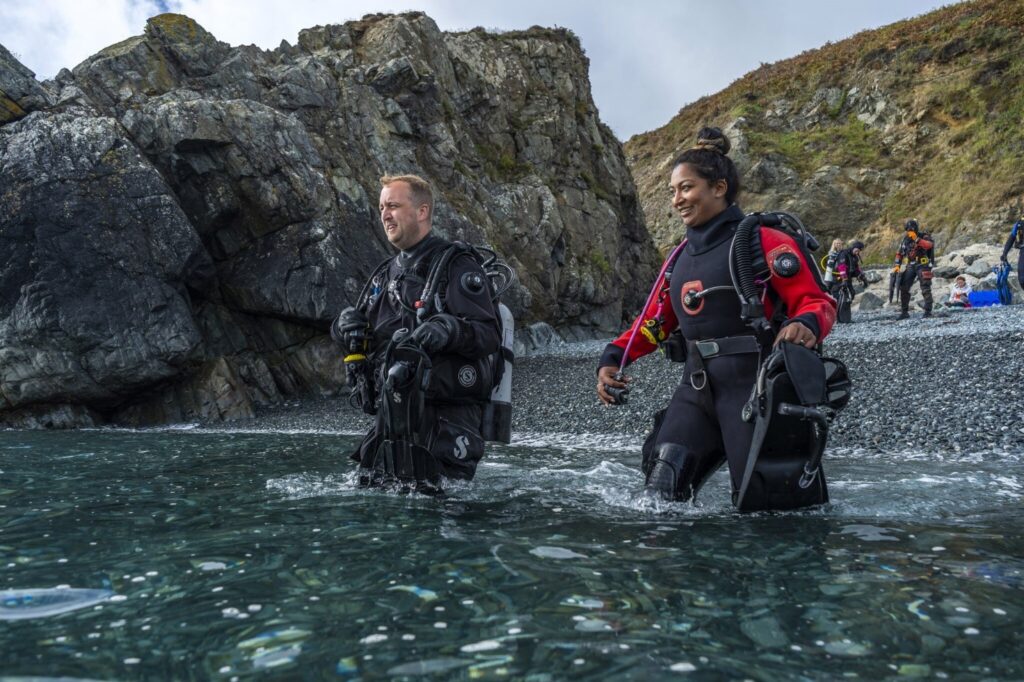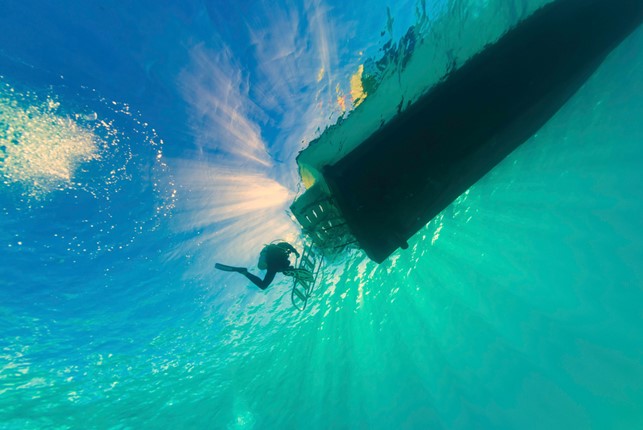We may be biased, but exploring the underwater world is den funnest experience on the planet. Even so, we as divers have to follow a few rules that hold secure us and make sure that the only surprises we encounter are good ones.
Whether you want diving tips for beginners or you're an experienced diver looking for a summary of safe diving practices, this list summarizes the golden rules of diving.
The rules for diving:
- Never hold your breath
- Plan your dive
- Dive within your limits
- Rise slowly (and don't forget your safety stop)
- Check your equipment
- Master your neutral buoyancy skills
- Never dive alone
- Monitor the gauges
- Keep fit
- Equalize your ears
- Do not fly immediately after diving
- Perform a pre-dive check
- No touching the marine life
- Get certified

Never hold your breath
The first rule of diving is to breathe continuously and never hold your breath. The effects of water pressure mean that the air inside your lungs expands as you ascend, and if you don't release it, it can cause lung damage. Keep breathing normally throughout your dive, and you will also feel calmer and bruge mindre gas, end hvis du holder vejret.

Plan your dive
Even if you follow a PADI Professional, thinking about your dive plan is the first step to a safe and enjoyable adventure. For example, it helps you prepare physically and mentally by:
- Knowing what equipment to bring
- Predicting and reducing risks
- Anticipate the conditions
- Calming nerves before the dive
Always plan the dive within no-decompression limits using a dive computer or dive tables. Consider the rule of thirds for breathing gas management. Above all must you stick to the mantra: "Plan the dive, dive the plan."

Dive within your limits
A little challenge can be rewarding, but pushing yourself too far is more likely to cause problems. There are some hard and fast diving rules, such as staying within the maximum depth limits you are certified for and whether you are qualified to do specialty diving, such as ice diving. Otherwise the boundaries are personal and can change from day to day, depending on things like how recently you've been diving and whether you have experience with the type of diving, placering eller forhold.

Rise slowly (and don't forget your safety stop)
One of the basic rules of diving is to practice safe ascents. This reduces the risk of decompression sickness (DCS), also known as "the bends". First, you must be a SAFE diver: Ascend slowly from each dive at a rate of no faster than 18 meters / 60 feet per minute. Then, as an added safety precaution for recreational diving, make a safety stop at 5 meters/15 feet for at least three minutes (technical diving generally requires additional stops).

Check your equipment
As your lifeline underwater, you should check your diving equipment thoroughly before each dive. For example:
- Is it complete, assembled and suitable for the dive?
- Are you trained and familiar with how to use it?
- Is it well maintained and functioning properly?
- Is your scuba tank full?Is your scuba tank full?
Selvom det er sjældent, kan det være farligt, hvis dykkerudstyr ikke fungerer under vandet, så dette er en anden dykkerregel, du ikke må ignorere.
Master your neutral buoyancy skills
Practicing and honing your buoyancy and weighting skills makes for a safer and happier dive. You will be able to control your ascents and descents, float motionless and glide effortlessly through the water. In addition helps correct adjustment of your buoyancy to the depth and conditions dig med at spare gas and avoid damaging marine life.

Never dive alone
A shared dive is a safe dive. No matter how experienced you are, never dive without a buddy. We use the buddy system to reduce risk and help in an emergency, but your buddy can also help with navigation, equipment use and fish identification. Of course, it's not just about rules in diving; Having a friend means you have someone else to share your unfiltered, epic adventures with!
Get a new dive buddy
Hvis du vil dele din passion med de mennesker, du holder mest af, så konverter dine venner til dykkere og begiv dig ud på et nyt kammerateventyr sammen. Inviter dine venner til at lære at dykke.

Monitor the gauges
With the help of diving watches, diving pressure gauges (SPGs) and/or dive computers, we can monitor key dive statistics including depth, gas and bottom time. This helps us maintain our diving schedule and avoid difficult situations, such as running out of gas. Factors such as depth, temperature and exertion can all affect gas consumption, so diving safety rules include checking your gauges or computer every few minutes to prevent surprises.

Keep fit
As a diver, you may carry heavy equipment, learn new skills, or encounter strømme. Support a healthy body and mind by following these important guidelines for diving, and you will be better equipped to handle any mental and physical demands.
- Don't drink and dive
- Get plenty of rest
- Stay physically fit
- Never dive with a cold
- Eat well
- Practice mindfulness
Try to dive regularly so that your diving skills also stay in shape. You may benefit from additional training or, if it's been a while since your last dive, a quick dive refresher.
Udlign ofte
En kardinal dykkersikkerhedsregel er at udligne ofte, når man går ned for at forhindre ørebarotraumer. Hvis du kæmper for at “rense dine ører”, så fortæl det til din ven, stig lidt op og prøv igen. Hvis det stadig ikke virker, skal du afslutte dykket; Never continue down if your ears hurt, as it can lead to long-term damage.

Do not fly immediately after diving
With countless incredible diving destinations to explore, we must keep in mind the rules of diving and flying. Because of how residual nitrogen in our bodies reacts to the rapid change in pressure during a flight at altitude, flying after diving can lead to decompression sickness. As such, the recommendation is to wait 12 to 24 hours before flying after a dive.

Perform a pre-dive check
A pre-dive check (or "buddy check") is the best way to catch and prevent potential problems before a dive. Together with your friend you can:
- Test that your equipment is working correctly (and that your gas is “on”)
- Review your dive plan and emergency procedures
- Familiarize yourself with your friend's equipment
- Summarize or learn diving signals you will use together
Whether you follow the “BWRAF” or another checklist, one of the best rules in diving is to complete your pre-dive checks before every dive

No touching the marine life
This is arguably the most important rule of diving for marine conservation: do not touch the marine life. Reef ecosystems are fragile and even the slightest touch can be harmful. Second, you may suffer a painful bite, burn, or sting if you disturb poisonous creatures. Instead, appreciate the marine wildlife from a safe distance and capture your memories with photos and videos.
